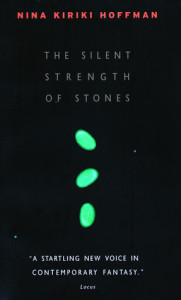 In The Thread That Binds The Bones, Nina Kiriki Hoffman introduces Tom Renfield, an odd young man who can see ghosts and who discovers in a time of crisis that he can even perform feats of magic. He flees the notoriety that this brings when others discover his secret, and ends up in the quaint little town of Arcadia, Oregon. Something is very wrong in Arcadia, though, as Tom learns when the beautiful Laura Bolte walks into the Dew-Drop Inn looking for a ride out to Chapel Hollow, the mysterious settlement where her bizarre and unique family lives in clannish seclusion.
In The Thread That Binds The Bones, Nina Kiriki Hoffman introduces Tom Renfield, an odd young man who can see ghosts and who discovers in a time of crisis that he can even perform feats of magic. He flees the notoriety that this brings when others discover his secret, and ends up in the quaint little town of Arcadia, Oregon. Something is very wrong in Arcadia, though, as Tom learns when the beautiful Laura Bolte walks into the Dew-Drop Inn looking for a ride out to Chapel Hollow, the mysterious settlement where her bizarre and unique family lives in clannish seclusion.
Within a few hours, Tom finds himself married to Laura; he finds himself a member of a Family that lives surrounded by Powers (spirits) and Presences (ghosts), a Family that lives by magical means, and terrorizes the good people of nearby Arcadia with cruel pranks and destructive spells. With the help of the ghost of Peregrine Bolte, Tom rescues two of the Family’s tormented slaves and sets in motion a chain of events that will ultimately reveal the evil that lurks at the heart of the Family and heal the rift between the Family and the Arcadians.
The Silent Strength of Stones was published two years after The Thread That Binds The Bones, and though it centers on members of the Family it is not a sequel to Thread. In fact, there are clues that suggest that the second novel takes place prior to the first.
 The Silent Strength of Stones also takes place in Oregon, at the fictitious Sauterelle Lake. Nick Verrou is a lonely 17-year-old who works for his father; Dad operates a small motel and general store in the little community in the Cascade Mountains. Nick’s mother left when he was 13, his father is overbearing and controlling, and his grandfather is elderly and senile.
The Silent Strength of Stones also takes place in Oregon, at the fictitious Sauterelle Lake. Nick Verrou is a lonely 17-year-old who works for his father; Dad operates a small motel and general store in the little community in the Cascade Mountains. Nick’s mother left when he was 13, his father is overbearing and controlling, and his grandfather is elderly and senile.
Nick amuses himself by sneaking around spying on guests at the resort across the lake. But this time Nick finds out more than he bargains for when he meets the odd family staying in Cabin 5. He’s attracted to the beautiful Willow … and then he finds out that she can disappear. He meets the family dog … a wolf who can talk, and who happens to be Willow’s brother, Evan. He angers Willow’s aunt and uncles, and discovers that these frightening people can threaten him with magic that he never dreamed of.
Then he must decide what to do when his mother returns and he discovers that he has the same magical gifts as the odd Family of visitors.
Both Thread and Stones are thoroughly enjoyable books, and I must say that Hoffman is for the most part a superb writer. Her imagery is wonderful, and she can seduce a reader into a story quickly and neatly. And her imagination is fantastic. I love her ideas and plotlines. This being said, I have to admit that while I like both of these novels, I also find them a little disappointing.
Most of Hoffman’s characters are psychologically damaged in some way. Both Tom and Nick have abandonment and attachment issues. Most of the characters in both books are wounded people. The problem is, Hoffman makes it far too easy for these scarred and damaged people to recover. Time and again, seemingly cruel and arrogant characters are shown the error of their ways and suddenly vow to reform, no questions asked.
Where Hoffman begins by creating real people with real issues, she ends by turning them into two-dimensional figures that behave unrealistically simply to drive the plot forward into the next scene. The effect is contrived, and beneath the talent that I see in the author.
Because of this, both books move from scene to scene erratically. Event A happens. The scene ends. Event B happens. The scene ends. Event C happens, and so forth. The flow, especially in Thread, is never quite smooth, never quite lifelike. As a reader, I need more. I want to be transported into the tale. I want to forget that it’s a story. I want to meet characters that are real people, and make me care about what happens to them. Unfortunately, neither book ever completely satisfies these needs. Almost, just not quite.
Hoffman also has difficulty convincing me that her characters are real when it comes to their reactions to magic. While I’m sure most of us who devote our lives to myth and magic would love to think that if it happened to us, we’d be instantly accepting of it, the sad truth is that we would likely be just as panicked at the sight of real magic as any unbeliever. We might recover more quickly and be able to flow with it, but I would bet that most if not all of us would still take a bit of time to get used to it.
Hoffman’s characters, however, are introduced to magic without even blinking. A character disappears, and no one faints. A character is transformed into an animal, and it doesn’t even faze him. This is incredibly distracting! Nothing seems to shock or frighten these people, and as a consequence, they seem a touch surreal.
Finally, the ending of Thread was extremely dissatisfying. It was almost as if Hoffman ran out of ideas and just stopped. I felt that more needed to be said. Fortunately, Stones ends in just the opposite way, and I found the climax quite adequate.
The Thread That Binds The Bones and The Silent Strength of Stones are both fun to read, with the caveat that the reader not expect too much in the way of character development. I do recommend both books, though not as wholeheartedly as I might wish. Hoffman is amazingly talented, though, and I can’t wait for more.
(Avon Books, 1993 and 1995)

